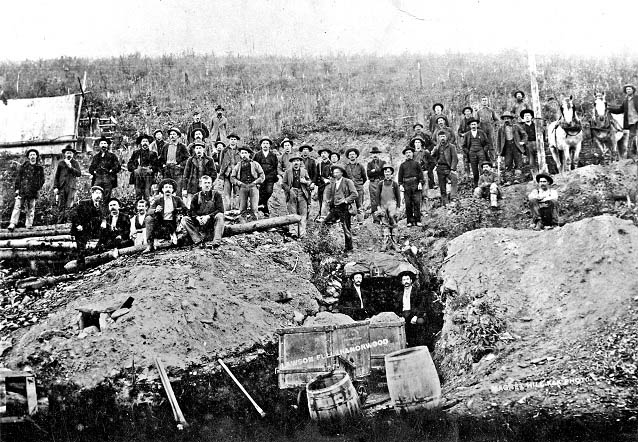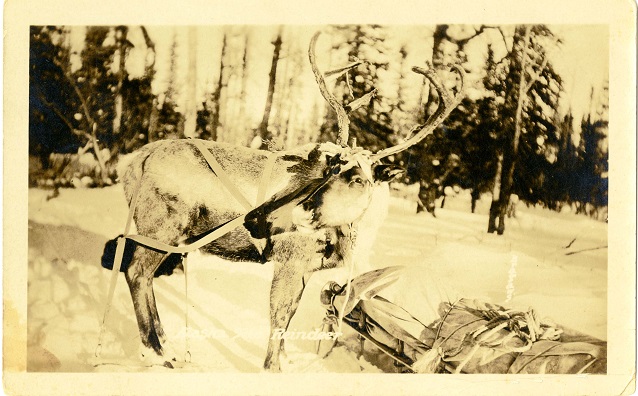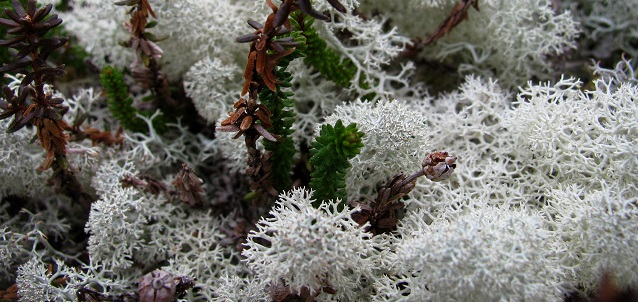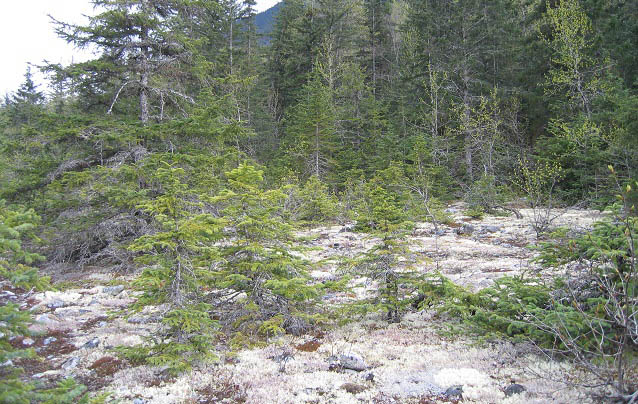A booming frontier town in the far reaches of the north. An influx of gold seekers. A long winter with frozen rivers cutting off supply delivery. The solution? Reindeer to the rescue!

National Park Service, Klondike Gold Rush National Historical Park, George and Edna Rapuzzi Collection, KLGO 55804. Gift of the Rasmuson Foundation.
With the best of intentions, on December 18, 1897, President William McKinley signed legislation to get food to starving miners in the Yukon gold fields. The government, nothing if not original in this case, arranged for the purchase of some 500 reindeer from Lappland (or Norway) and the hiring of Lapp herders. The reindeer were to carry rescue supplies over the Chilkoot Pass to Dawson. It would have been a sight to see – trained reindeer carrying packs or pulling sleds and climbing the Golden Stairs to the summit, herded by Lapp men and women. But as sometimes happens with innovative government schemes, things did not go quite as planned. It turned out the miners weren’t really starving and most of the reindeer died near Haines. But it does make for an interesting story.
The Klondike Gold Rush can be considered the catalyst that set this story in motion. The major part of the rush began in July, 1897, with the arrival of the gold ships Excelsior in San Francisco and Portland in Seattle. At that time new town of Dawson was primarily supplied by paddlewheelers coming up the Yukon River from St. Michael. They were small steamers and not in a position to greatly increase the amount of food delivered before winter if Dawson’s population suddenly were to increased but that is exactly what it did due to the gold rush. The problem was compounded by unusually low Yukon River water levels, which prevented some late-season trips to Dawson. Outfitters began severely restricting what they sold, while those individuals who had extra food to sell could realize large profits. Fifty pound bags of flour that cost $6 now could bring $50 or more.
In order to get an account of the situation, on August 3 the Secretary of War, Russell Alger, ordered Captain Patrick Henry Ray to travel up the Yukon River. He arrived at Fort Yukon on September 12 and reported he couldn’t get to Dawson due to the low water levels. By the end of November he had gotten three communications to Alger, but still had not made it to Dawson.
Other reports coming out of Dawson were mixed on the food situation, but some people were fleeing the city.
By September there were widespread newspaper articles about possible food shortages. Petitions and pleas were going to President McKinley and Congress, asking for relief. But if assistance was to be provided, how was it to be done? Getting supplies through in the winter would not be an easy task. One suggestion given serious consideration was to haul food to Dawson on steam snow locomotives traveling over the Chilkoot Pass or some other route.
Another option centered on reindeer. But first, what were reindeer doing in Alaska? Reindeer are an Old World animal, ranging across the northern reaches of Scandinavia and Russia. They are, in fact, the same species as caribou, which are found in the western hemisphere. But, while caribou are wild, some reindeer were domesticated and used as herd animals. It was as domesticated animals that reindeer were brought into Alaska from Siberia. The idea was to train natives in animal husbandry and turn them from hunting to agriculture. The animals could provide subsistence as sources of meat, milk, and hides, and could be used as draught animals.
The reindeer visionary was Sheldon Jackson, a Presbyterian missionary and the government’s General Agent of Education for Alaska. When he was appointed in 1885, his $2,400 salary was shared by the government and the Presbyterian Board of Home Missions, an arrangement that would not work today. At the time many of the Alaskan schools were affiliated with church groups. In 1891, on a voyage to inspect schools for the Department of the Interior, Jackson took a detour to Siberia and acquired 16 reindeer, which he brought to Alaska to see if they would survive. In 1892 he established the Teller Reindeer Station on the Seward Peninsula north of Nome. Over the next few years, he brought back more Siberian reindeer. By the time of the gold rush, there were several western Alaskan reindeer stations.
Congress, beginning in 1893, appropriated funds to purchase reindeer to be used in native education. By 1897, there were hundreds of government-owned reindeer in Western Alaska. Probably at the suggestion of Jackson, in September President McKinley approved a Yukon River valley relief plan using these reindeer. William Kjellmann, who worked with Jackson in Alaska, was to coordinate the efforts under the direction of officers of the U.S. Army stationed at St. Michael, Alaska. A telegram was sent to Kjellmann on September 22. He probably did not receive it until October, when he began organizational work. Before long, though, the project was effectively cancelled and Kjellmann was called to Washington for consultations.
Concurrently, another crisis was hitting the headlines. In the Arctic Ocean near Point Barrow, Alaska, whaling vessels were caught in the ice. By early November, word had been received that eight vessels were involved, that some were damaged, and that there was not enough food for survival. The President, following a conference with his cabinet and others, decided to take action. This included enlisting the help of reindeer and herders in western Alaska. The effort to get the reindeer to the trapped men was successful when, on March 30, 1898, 382 reindeer make it through. But the whaling rescue mission depleted the Alaskan reindeer herds that could be used for another relief project.
Secretary of War Alger in early December told Congress that, unless supplies went to the Klondike, many would suffer extreme want. On December 9, Congressional debate began on a joint resolution calling for the distribution of “food and other supplies furnished by or under the direction of the Portland Chamber of Commerce of Portland, Oregon.” That organization had been prominent in raising the alarm and offering assistance. The proposed resolution did not mention reindeer or extending relief to Canada.
Before and during Congressional debate, Sheldon Jackson was apparently active behind the scenes promoting the use of reindeer and herders from Lappland. Looking beyond the immediate crisis, he viewed them as boosting his goal of establishing domesticated reindeer in Alaska. He found the supply of reindeer from Siberia to be inadequate in number, and the herders from Siberia to be unsatisfactory. He also thought it was important to shift the emphasis from providing the coastal Alaska native communities with a food supply, to providing them with draught animals to replace their dogs for hauling supplies for white miners. Finally, Jackson saw it as an opportunity to spread reindeer stations into the Yukon River valley.
The act the president signed December 18 appropriated $200,000 for the Secretary of War to purchase subsistence stores, supplies, and materials, and to provide relief. The relief could be extended to Canada with that government’s consent. As part of the legislation, the Secretary could purchase and import reindeer “and employ and bring into the country reindeer drivers or herders not citizens of the United States.” Upon the conclusion of the relief project, the reindeer could be sold or turned over to the Department of the Interior, the department that employed Jackson.

National Park Service, Klondike Gold Rush National Historical Park, Shoemaker Collection, KLGO 38210.
Kjellmann, in anticipation of the legislation’s introduction and passage, set out on December 1, 1897 from New York for Finnmark province, north of the Arctic Circle in Norway. here he began his search for suitable, harness-trained reindeer and their herders. Jackson followed, going to England and Norway once the legislation passed. He traveled with an army officer who acted as paymaster. Reindeer and herders were available, but there were delays compounded by bad weather, the search for a suitable ship, problems with money transfer, a lawsuit over breach of contract, and the need to load enough reindeer moss (actually a type of lichen) for the trip. The belief was that the reindeer would be able to subsist on Alaskan caribou moss (also a lichen) upon their arrival in Dyea. Once there, they were to be driven over the Chilkoot Pass and across country to Dawson and other areas experiencing starvation. The food was to be given away, or paid for if the miners could afford it.
The reindeer and herders steamed from Finnmark province on February 4, well behind the hoped-for January 20 departure. On board were some 538 reindeer, 418 sledges, and 511 harnesses. Herders totaled 72 (including four women) with families bringing the total to 113, not to mention the herd dogs. Herder salaries were 1,000 kroner a year or about $250.
The reindeer ship, the Manitoban, finally arrived in New York City on February 28, and on March 1 loaded the reindeer and herders onto a chartered special train in Jersey City. The reindeer and herders attracted considerable attention, both in Jersey City and after their March 8 arrival in Seattle, when the reindeer were settled into Woodland Park. Most of the reindeer survived the journey. The same could not be said about the relief expedition. Headlines in the March 2 New York Times read, “Klondike Relief Useless/The Federal Government Abandons the Proposed Reindeer Expedition/No Danger of Starvation/Secretary Alger Says Conditions Have Changed—Reindeer and Supplies to be Offered for Sale.”
Indeed, it appears that the concerns about mass starvation were overblown and that limited and contradictory information was misinterpreted. Part of the pressure on Dawson was ameliorated by the exodus of some residents in the fall and winter. While there was little food for sale in Dawson, most residents had adequate food on hand to last until the first supplies came by river in May.
Talks had taken place with Canadian officials, most of whom took a skeptical view of what the Americans were trying to do in Canada. Mountie Sam Steele commented in his book, Forty Years in Canada, that in Dyea, he “had the pleasure of dining with Major Rucker, of the United States Army, and two of his officers, who were in charge of a large quantity of provisions for American citizens, who were alleged to be starving at Dawson and other parts of the Yukon.” Later, he refers to Yukon Commissioner James Walsh and staff, who went to Dawson May 3. Steele observed, “The American Relief Expedition, which he had expected to meet, had been cancelled, as there were no starving people to feed.”
After some indecision, the U.S. government decided on a modified expedition, with a small army escort, leaving from Haines over the Dalton Trail. This was more of a trial for the reindeer than a relief expedition. In addition, two other Army expeditions in Alaska were to use reindeer. On March 17, the reindeer party left Seattle and sailed up the coast, with the animals and many of the herders arriving in Haines March 28. There were 521 reindeer reported alive out of the original 538. But this situation quickly changed as the reindeer moss (a type of lichen) they had brought ran out and there was insufficient Alaskan lichen to replace it. Deer started to weaken and die. The Copper River and Cook Inlet U.S. Army expeditions apparently decided the reindeer were not fit for travel and did not take them.

NPS photo
As there was insufficient reindeer fodder near Haines, the herders soon began driving the animals inland toward the Chilkat Pass. Many reindeer died on the trip, and even the herders were poorly fed. Fortunately by May 6 the herders found a better lichen supply for the 185 surviving reindeer. At that point William Kjellmann, who had been in charge, left the reindeer with 15 herders. The rest of the herders returned to Haines. Many were hired for three-year terms to work with reindeer stations in Alaska. Afterwards, some continued to work successfully with their own reindeer herds and most became citizens and settled in the Alaska District or elsewhere in the U.S.

NPS photo/J. Belt
What of the reindeer? The weakened remnants were taken to graze about 50 miles from Haines, where there was a good lichen supply. In September 1898 a group of herders, without army escort, commenced to take reindeer overland toward Circle City, Alaska. There are reports along the route by people who saw what one diary referred to as “this great sight.” After a 1,000 mile trek, the party arrived in Circle City on February 28, 1899, with 114 surviving reindeer. One unconfirmed report says that, following the journey, many of the reindeer escaped and joined a band of Alaskan caribou.
While the Yukon Relief Expedition didn’t exactly live up to its billing, Sheldon Jackson continued to promote reindeer use and propagation in Alaska, now with the help of the “superior” Lapp herders. By 1936 reindeer numbers peaked at 600,000. Today, domesticated reindeer herds are established in areas of Alaska and Canada, thanks in part to the early boost given by the abortive relief efforts during the Klondike Gold Rush.
About this article
This article was researched and written by David Simpson, a Student Conservation Association Intern who worked for Klondike Gold Rush National Historical Park during the 2011 and 2012 seasons and has been edited by myself. Information for this program was supplied by the following books:
Lokke, Carl L., Klondike Saga: The Chronicle of a Minnesota Gold Mining Company, University of Minnesota, Minneapolis, 1965 (see esp. P. 133).
Rausch, V.R., and Baldwin, D.L., Eds., The Yukon Relief Expedition and the Journal of Carl Johan Sakariassen, University of Alaska, Fairbanks, 2002.
Rinaldo, Peter M., The Great Reindeer Caper: The Missionary and the Miners, DorPete, Briarcliff Manor, NY, 1997, 120p.
Steele, Sam, Forty Years in Canada, Herbert Jenkins, London, 1935.
Last updated: March 21, 2024
